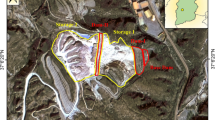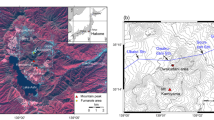Abstract
The Jianshanying landslide in Guizhou province, China, is a typical mining-induced landslide with its complex formation in karst mountainous area. However, the spatiotemporal deformation characteristics and failure mechanism are still unknown. In this paper, the surface deformation time series from 2017 to 2020 is firstly estimated by combining multi-temporal synthetic aperture radar (SAR) interferometry and improved offset-tracking methods to overcome the difficulties caused by the large gradient surface deformation and surface material changes. Then, the spatiotemporal characteristics of Jianshanying landslide is analyzed in terms of line-of-sight (LOS) deformation with stacking InSAR method and two-dimensional (2D) deformation with improved SAR offset-tracking method. And the different deformation features between sliding body and surrounding areas are uncovered. Accordingly, we point out the “three-section” surface deformation model. We further analyze the deformation time series by considering the joint effects of rainfall and underground mining. Finally, we conceptualize the landslide failure mode for the Jianshanying landslide, which can be extended to the similar landslide in karst mountainous areas of southwestern China.













Similar content being viewed by others

References
Berardino P, Fornaro G, Lanari R, Sansosti E (2002) A new algorithm for surface deformation monitoring based on small baseline differential SAR interferograms. IEEE Trans Geosci Remote Sens 40:2375–2383. https://doi.org/10.1109/TGRS.2002.803792
Chen L, Zhao C, Kang Y, Chen H, Yang C, Li B, Liu Y, Xing A (2020) Pre-event deformation and failure mechanism analysis of the Pusa Landslide, China with multi-sensor SAR imagery. Remote sensing 12 doi:https://doi.org/10.3390/rs12050856
Fan X, Xu Q, Scaringi G, Zheng G, Huang R, Dai L, Ju Y (2019) The “long” runout rock avalanche in Pusa, China, on August 28, 2017: a preliminary report. Landslides 16:139–154
Frattini P, Crosta GB, Rossini M, Allievi J (2018) Activity and kinematic behaviour of deep-seated landslides from PS-InSAR displacement rate measurements. Landslides 15:1053–1070
Global Precipitation Measurement. https://gpm.nasa.gov/data/directory.
Goldstein RM, Werner CL (1998) Radar interferogram filtering for geophysical applications. Geophys Res Lett 25:4035–4038
Hanssen RF (2001) Radar interferometry: data interpretation and error analysis vol 2. Springer Science & Business Media
Hu X, Buergmann R, Fielding EJ, Lee H (2020a) Internal kinematics of the Slumgullion landslide (USA) from high-resolution UAVSAR InSAR data. Remote Sens Environ 251:112057. https://doi.org/10.1016/j.rse.2020.112057
Hu X, Burgmann R, Schulz WH, Fielding EJ (2020b) Four-dimensional surface motions of the Slumgullion landslide and quantification of hydrometeorological forcing. Nat Commun 11:1–9. https://doi.org/10.1038/s41467-020-16617-7
Huang L, Li Z (2011) Comparison of SAR and optical data in deriving glacier velocity with feature tracking. Int J Remote Sens 32:2681–2698. https://doi.org/10.1080/01431161003720395
Huang M, Qi S, Shang G (2012) Karst landslides hazard during 1940-2002 in the mountainous region of Guizhou Province, Southwest China. Nat Hazards 60:781–784. https://doi.org/10.1007/s11069-011-0018-z
Huang Q, Cai Y, Xing X (2008) Rocky desertification, antidesertification, and sustainable development in the karst mountain region of Southwest China. AMBIO: A Journal of the Human Environment 37:390–392
Hungr O, Leroueil S, Picarelli L (2014) The Varnes classification of landslide types, an update. Landslides 11:167–194
Kang Y, Lu Z, Zhao C, Zhang Q, Kim J-W, Niu Y (2019) Diagnosis of Xinmo (China) landslide based on interferometric synthetic aperture radar observation and modeling. Remote Sensing 11 doi:https://doi.org/10.3390/rs11161846
Kang Y, Zhao C, Zhang Q, Lu Z, Li B (2017) Application of InSAR techniques to an analysis of the Guanling Landslide. Remote Sens 9. https://doi.org/10.3390/rs9101046
Li H, Dong J, Zhu Y, Zou Y, Ding H (2019) Characteristics and genesis mechanism of Jianshanying landslide in Faer coal mine, Guizhou province. Science Technology and Engineering 19:345–351
Liu X, Zhao C, Zhang Q, Lu Z, Li Z (2020) Deformation of the Baige Landslide, Tibet, China, revealed through the integration of cross-platform ALOS/PALSAR-1 and ALOS/PALSAR-2 SAR observations. Geophysical Research Letters 47 doi:10.1029/2019GL086142
Lyons S, Sandwell D (2003) Fault creep along the southern San Andreas from interferometric synthetic aperture radar, permanent scatterers, and stacking. J Geophys Res Solid Earth 108. https://doi.org/10.1029/2002JB001831
Massonnet D, Feigl KL (1998) Radar interferometry and its application to changes in the Earth's surface. Rev Geophys 36:441–500. https://doi.org/10.1029/97RG03139
Nishiguchi T, Tsuchiya S, Imaizumi F (2017) Detection and accuracy of landslide movement by InSAR analysis using PALSAR-2 data. Landslides 14:1483–1490
Pepe A, Lanari R (2006) On the extension of the minimum cost flow algorithm for phase unwrapping of multitemporal differential SAR interferograms. IEEE Trans Geosci Remote Sens 44:2374–2383. https://doi.org/10.1109/TGRS.2006.873207
Rott H, Stuefer M, Siegel A, Skvarca P, Eckstaller A (1998) Mass fluxes and dynamics of Moreno Glacier, Southern Patagonia Icefield. Geophys Res Lett 25:1407–1410. https://doi.org/10.1029/98GL00833
Sansosti E, Berardino P, Manunta M, Serafino F, Fornaro G (2006) Geometrical SAR image registration. IEEE Trans Geosci Remote Sens 44:2861–2870. https://doi.org/10.1109/TGRS.2006.875787
Schlögel R, Malet J-P, Doubre C, Lebourg T (2016) Structural control on the kinematics of the deep-seated La Clapière landslide revealed by L-band InSAR observations. Landslides 13:1005–1018
Schmidt DA, Burgmann R (2003) Time-dependent land uplift and subsidence in the Santa Clara valley, California, from a large interferometric synthetic aperture radar data set. Journal of Geophysical Research: Solid Earth 108:ETG4-1-13 doi:10.1029/2002JB002267
Singleton A, Li Z, Hoey T, Muller JP (2014) Evaluating sub-pixel offset techniques as an alternative to D-InSAR for monitoring episodic landslide movements in vegetated terrain. Remote Sens Environ 147:133–144. https://doi.org/10.1016/j.rse.2014.03.003
Solari L, Raspini F, del Soldato M, Bianchini S, Ciampalini A, Ferrigno F, Tucci S, Casagli N (2018) Satellite radar data for back-analyzing a landslide event: the Ponzano (Central Italy) case study. Landslides 15:773–782
Sun H, Zhang Q, Zhao C, Yang C, Sun Q, Chen W (2017) Monitoring land subsidence in the southern part of the lower Liaohe plain, China with a multi-track PS-InSAR technique. Remote Sens Environ 188:73–84. https://doi.org/10.1016/j.rse.2016.10.037
Wang J, Wang C, Xie C, Zhang H, Tang Y, Zhang Z, Shen C (2020) Monitoring of large-scale landslides in Zongling, Guizhou, China, with improved distributed scatterer interferometric SAR time series methods. Landslides 17:1777–1795. https://doi.org/10.1007/s10346-020-01407-5
Wasowski J, Pisano L (2020) Long-term InSAR, borehole inclinometer, and rainfall records provide insight into the mechanism and activity patterns of an extremely slow urbanized landslide. Landslides 17:445–457
Yue X, Wu S, Huang M, Gao J, Yin Y, Feng A, Gu X (2018) Spatial association between landslides and environmental factors over Guizhou Karst Plateau, China. J Mt Sci 15:1987–2000. https://doi.org/10.1007/s11629-018-4909-2
Zhang Y, Xing A, Lin K, Zhuang Y, Bilal M, Xu S, Zhu Y (2020) Investigation and dynamic analyses of rockslide-induced debris avalanche in Shuicheng, Guizhou, China. Landslides 17:2189–2203. https://doi.org/10.1007/s10346-020-01436-0
Zhao C, Lu Z, Zhang Q (2013a) Time-series deformation monitoring over mining regions with SAR intensity-based offset measurements. Remote Sensing Letters 4:436–445. https://doi.org/10.1080/2150704X.2012.746482
Zhao C, Zhang Q, Yin Y, Lu Z, Yang C, Zhu W, Li B (2013b) Pre-, co-, and post- rockslide analysis with ALOS/PALSAR imagery: a case study of the Jiweishan rockslide, China. Nat Hazards Earth Syst Sci 13:2851–2861. https://doi.org/10.5194/nhess-13-2851-2013
Acknowledgements
We would like to thank JAXA, Japan, to provide the ALOS/PALSAR-2 data. And one arc-second SRTM DEM is freely downloaded from the website https://e4ftl01.cr.usgs.gov/MEASURES/. Some mapping software, such as ArcGIS and Origin are used.
Funding
This work was funded by the National Key Research and Development Program of China (Grant No. 2018YFC1504805) and the Natural Science Foundation of China (Grant Nos. 41731066, 41874005, 41929001).
Author information
Authors and Affiliations
Corresponding author
Rights and permissions
About this article
Cite this article
Chen, L., Zhao, C., Li, B. et al. Deformation monitoring and failure mode research of mining-induced Jianshanying landslide in karst mountain area, China with ALOS/PALSAR-2 images. Landslides 18, 2739–2750 (2021). https://doi.org/10.1007/s10346-021-01678-6
Received:
Accepted:
Published:
Issue Date:
DOI: https://doi.org/10.1007/s10346-021-01678-6



